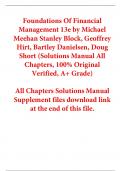Foundations Of Financial
Management 13e by Michael
Meehan Stanley Block, Geoffrey
Hirt, Bartley Danielsen, Doug
Short (Solutions Manual All
Chapters, 100% Original
Verified, A+ Grade)
All Chapters Solutions Manual
Supplement files download link
at the end of this file.
, Chapter 1
Discussion Questions
1-1. Regulation was increased with the Dodd – Frank Act and other measures. These measures
were intended to increase the transparency of financial institutions and to generally limit
speculative investing.
1-2. The student should be prepared to pay a higher price for the promised $2 from the Royal
Bank. The risk is lower.
1-3. The goal of shareholder wealth maximization implies that the firm will attempt to achieve
the highest possible valuation in the marketplace. It is the one overriding objective of the
firm and should influence every decision. The problem with a profit maximization goal is
that it fails to take account of risk, the timing of the benefits is not considered, and profit
measurement is a very inexact process.
1-4. Agency theory examines the relationship between the owners of the firm and the managers
of the firm. In privately owned firms, management and the owners are usually the same
people. Management operates the firm to satisfy its own goals, needs, financial
requirements and the like. As a company moves from private to public ownership,
management now represents all owners. This places management in the agency position of
making decisions in the best interest of all shareholders.
1-5. Because institutional investors such as pension funds (Ontario Teachers, CPP) and mutual
funds own a significant percentage of major companies, they are having more to say about
the way publicly owned companies are managed. As a group, they have the ability to vote
large blocks of shares for the election of a board of directors, which is supposed to run the
company in an efficient, competitive manner. The threat of being able to replace poorly
performing boards of directors makes institutional investors quite influential. Since these
institutions, like pension funds and mutual funds, represent individual workers and
investors, they have a responsibility to see that the firm is managed in an efficient and
ethical way.
1-6. Insider trading occurs when someone has information that is not available to the public and
then uses the information to profit from trading in a company’s common stock. The
provincial securities commissions are responsible for protecting against insider trading.
1-7. Pollution controls and other socially acceptable practices may at times be inconsistent with
a corporation’s objective to achieve the highest possible value, however they should still
be pursued. Maximization of shareholder wealth can still be achieved in the long run as
corporations adapt and evolve to these new requirements. Regulations set the “rules of the
game” in which the firm operates. Shareholder wealth maximization can and should still
be sought within the rules, for economic efficiency to be achieved. Society judge’s
deregulation benefits against the costs of regulation.
1-1
Foundations of Financial Management 13ce Block/Hirt/Danielsen/Short/Meehan
© 2024 McGraw Hill LLC
, Chapter 1
1-8. Management operates within a competitive market, and they should be paid their
opportunity cost. If managers do not act to maximize shareholder wealth, share prices will
become depressed. To the extent manager’s compensation is tied to share price
performance, shareholders can fire managers, and there exists a market for corporate
control, management will be compensated based on their economic contribution.
1-9. Daily functions- cash management, inventory control, receipt and disbursement of funds.
Occasional- share issue, bond issue, capital budgeting and dividend decisions.
1-10. There is unlimited liability for the sole proprietorship and partnership forms of ownership.
Under the limited partnership, only the general partner(s) has unlimited liability, with
limited partners obligated only to the extent of their initial contribution. Finally, all
shareholders in a corporation have limited liability, although owner/ shareholders of small
businesses often have to give banks their personal guarantees.
1-11. The corporate form is best suited to large organizations because of the easy divisibility of
ownership through issuance of shares. The corporation finds it easier to raise capital. Also,
the corporation has continued existence independent of any shareholder.
1-12. Money markets refer to those markets dealing with short-term securities that have a life of
one year or less. Capital markets refer to securities with a life of more than one year.
1-13. A primary market refers to the use of the financial markets to raise new funds. After the
securities are sold to the public (institutions and individuals), they trade in the secondary
market between investors. It is in the secondary market that prices are continually changing
as investors buy and sell securities based on the expectations of corporate prospects. A
liquid secondary market promotes a successful primary market.
1-14. Government debt loads require financing. This puts large demands on the capital markets,
putting upward pressure on interest rates and a corporation’s ability to invest in capital
projects. When governments finance their deficits abroad, they place Canada’s economic
levers outside of our control and debt servicing payments can impact the foreign exchange
markets. As the government debt load relative to GDP been reduced in recent years there
has been less pressure on interest rates, corporations have borrowed more, but there have
been less ‘risk free’ government securities available (causing liquidity problems
particularly in the money markets).
1-15. Stakeholders include: shareholders, creditors, employees, unions, environmentalists,
consumer groups, Canada Revenue Agency, government regulatory bodies, customers,
managers, and others.
1-2
Foundations of Financial Management 13ce Block/Hirt/Danielsen/Short/Meehan
© 2024 McGraw Hill LLC
, Chapter 1
Internet Resources and Questions
1. The Nobel Prize
2. Department of Finance Canada Budget
3. Bank of Canada
4. Onex Corporation
Royal Bank
5. BCE
1-3
Foundations of Financial Management 13ce Block/Hirt/Danielsen/Short/Meehan
© 2024 McGraw Hill LLC




